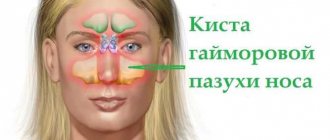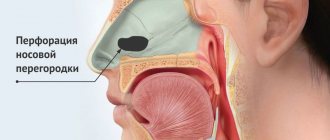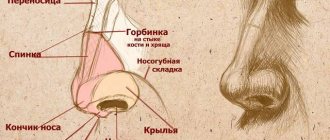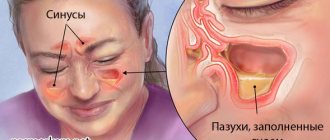A sinus cyst is a benign neoplasm that develops on the mucous membrane. Until a certain time, a person may not even be aware of its presence. According to statistics, about 15% of the world's population suffers from cysts in the nose. Cysts in the paranasal sinuses are quite common. A cyst in the sinus can be treated without surgery. This formation does not always require removal, and the patient’s condition can be alleviated using medication.
The difficulty of treatment lies in its localization inside the sinus, a kind of bone sac that cannot be washed or cleaned by external actions. In non-surgical treatment, various medications and some traditional medicine methods are used.
Cyst in the nose: what is it?
A cyst in the nose is a benign formation in the paranasal cavity (most often in the maxillary cavity), filled with a liquid component and enclosed in a dense capsule. At the primary stage of development, this neoplasm does not manifest itself in any way and does not bother the patient. The presence of a cyst is mainly diagnosed by chance, during the next x-ray or examination by an ENT doctor. At first, the cyst does not cause pain, does not disrupt the breathing process, and does not provoke any other clinical symptoms.
The mechanism of cyst formation is simple - in the zone of two-layer mucous epithelium, due to blockage of the excretory channels, a cystic cavity is formed. Its volume is filled with secretion produced by the inner epithelial layer. It is unable to leave due to disruption of the cells of the upper layer of the mucosa. Thus, a capsule filled with liquid secretion is obtained.
Features of the tumor
Cyst in the sinus
The inner surface of the nasal sinus is covered with mucous membrane. It contains glands that form a special mucus that plays the role of a protective barrier and prevents this internal cavity from drying out. When the nasal ducts are blocked, mucus begins to accumulate, which leads to the formation of a pathological convex container, characterized by thin and very elastic walls.
Is this condition dangerous? The formation in the nose is not dangerous and is called a cyst. Appears due to formation from its own tissues.
The main causes of cysts
A similar disease can occur in both adults and children. The causes of pathological processes inside the ducts are:
- inflammation of the upper teeth or jaw;
- abnormal structure of the nose and nasopharynx;
- allergic rhinitis;
- polyps in the nasopharynx;
- chronic sinus diseases;
- the body's tendency to allergic reactions;
- rhinitis and other pathologies.
Sometimes the disease develops under poor working conditions. This is, for example, polluted or hot indoor air, chemical fumes, etc. Such conditions entail hyperactivity of the mucous membrane, the body’s attempts to compensate for the lack of hydration.
Cyst formation
Reasons for appearance
The appearance of bubbles is due to the deterioration of the processes of fluid drainage from the sinuses. The reason for this is blockage of the ducts, which leads to the accumulation of fluid and constant stretching of the walls. Numerous factors can cause this phenomenon:
- Swelling and formation of hematomas due to injuries in the nasal area.
- A sinus cyst may be the result of polyps that make breathing difficult by creating increased pressure in the nose.
- Allergy.
- Susceptibility to regular colds. As a result of hypothermia, the blood vessels begin to narrow, causing inflammation and cyst formation.
- Inflammatory phenomena occurring in the root zone of teeth located in the upper jaw.
- Congenital or acquired abnormalities in the structure of the nasopharynx.
Structure of the sphenoid sinus
This part of the human body has several structural features:
- It is associated with cavernous vessels and connects with nerve fibers.
- The back wall comes into contact with Turkish cider.
- Refers to the posterior sinuses of the nose.
- Does not have fixed parameters.
- When large in size, it spreads to part of the occipital bone.
- The passage is divided into 2 halves: right and left, separated by partitions.
- Located in the body of the sphenoid bone.
It is noteworthy that the parameters and shape of the sinus are an individual feature of the structure of the human body.
Classification of pathology
In medicine, it is customary to classify such neoplasms depending on the method of their formation:
- False cysts (pseudocysts) - in this case, other tissues begin to play the role of the mucosa. The main cause of tumor development is the inflammatory process that develops in the area of the upper row of teeth.
- True (retention) sinus cysts are formed from mucous tissue. Studies have shown that the main reason for the formation of such cavities is blockage of the microducts of the mucous gland.
In addition, depending on the area of localization, cysts in the nose can develop in the following areas:
- frontal sinus;
- maxillary sinus;
- sphenoid sinus;
- nasal septum;
- lattice pair labyrinth.
Statistics show that most of the cystic cavities in the nose were diagnosed in the frontal sinuses.
Prevention
To prevent the formation of a tumor in the sinuses, you need to follow the following recommendations:
- timely diagnose and treat sinusitis and rhinitis;
- prevent inflammation in the teeth and gums, treat or remove diseased teeth in a timely manner;
- correct the bite in childhood;
- prevent chronic nasopharyngeal diseases;
- remove polyps from the nose and paranasal cavities;
- avoid contact with allergens and treat any allergic manifestations.
To prevent the development of complications, you need to seek help from an otolaryngologist at the first symptoms of a cystic formation in the nose.
Symptoms and signs of sinus cysts
Symptoms may not appear for a long time. An asymptomatic course of the disease is observed in most patients. However, as the neoplasm progresses, signs of pathology can be expressed as:
- congestion that cannot be treated with conventional medications;
- labored breathing;
- pain in the projection of the sinus in which the cyst is localized. When pressed, it hurts more;
- pain radiates to the frontal, suborbital part of the skull, wings of the nose;
- feeling that there is a foreign body in the localization area;
- deterioration of condition with changes in atmospheric pressure;
- when a microbial agent is added, the symptoms resemble those of sinusitis.










